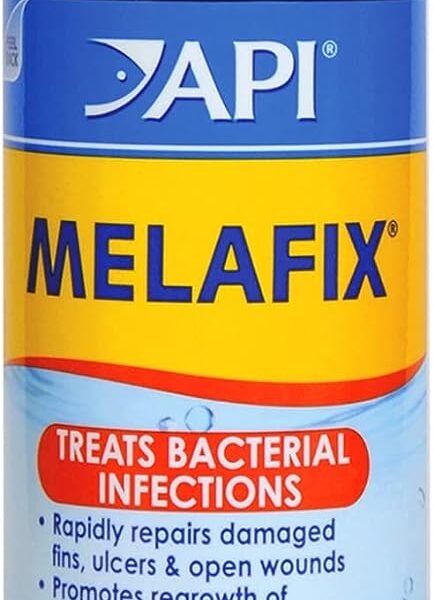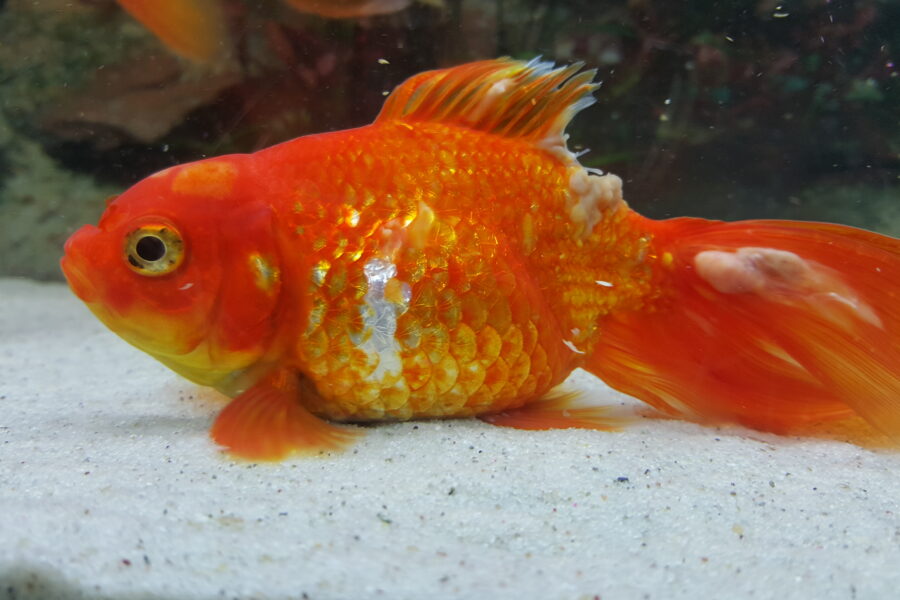
Snag your waders and grab your fishing pole as we dive into the underwater world of Anchor Worms in Goldfish. Yes, you heard me right! In this giggly guide, we’re going to navigate their lifecycle and what they’re all about.
Bait your hook for the second part of this aquatic journey – the strange love-hate bond between Goldfish and Anchor Worms. We’ll get up close and personal with the telltale signs of an unwelcome finned-guest!
Understanding Anchor Worms in Goldfish
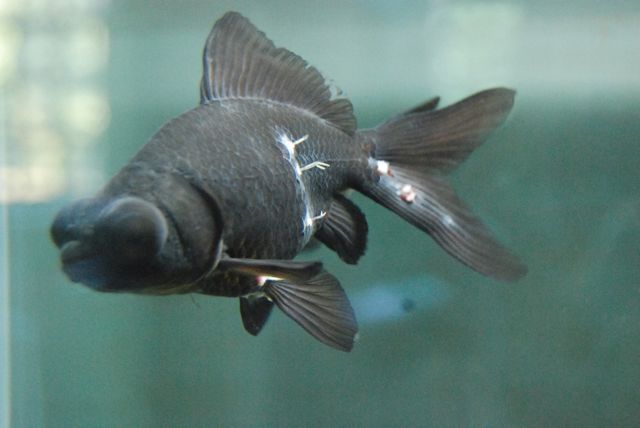
As a lover of goldfish or a budding aquarist, you may have heard the term ‘anchor worms’ passed around. And, if you’re anything like me, you might have imagined tiny pirate-themed worms causing havoc on the high seas of your aquarium! Alas, the reality is less humorous but equally important to know about.
What are Anchor Worms?
Alright, let’s do this! Anchor worms, also known as Lernaea, are not worms at all but crustaceans. Indeed, crustaceans! These little devils are parasites that attach themselves to fish, much like a hook and rope to an anchor – hence the name. They appear as small, thread-like protrusions, with a reddened area around the site of attachment. Not exactly the kind of bling your goldfish is looking for!
The Lifecycle of Anchor Worms
Get ready for some PG-13 content here folks! The lifecycle of an anchor worm – and it’s living the real circle of life – starts with the mating of male and female parasites. Post this romantic rendezvous, the male perishes (talk about a love sacrifice), and the female gets ready to go solo.
She lays eggs that latch onto aquatic plants and then hatch into free-swimming larvae. These larvae zipline onto the nearest fish (in our case, your beloved goldfish), and voila! The cycle begins anew. Love, death, and parasitism, all in one go, eh?
Now that we’ve opened the curtain on the world of anchor worms, let’s dive deeper (pun totally intended!). Upcoming, we’ll explore how these crustacean culprits make their way into your goldfish’s life, and the tell-tale signs that they’ve come to party. Gird your loins, fellow fish-lovers!
Goldfish and Anchor Worms: A Parasitic Love Story
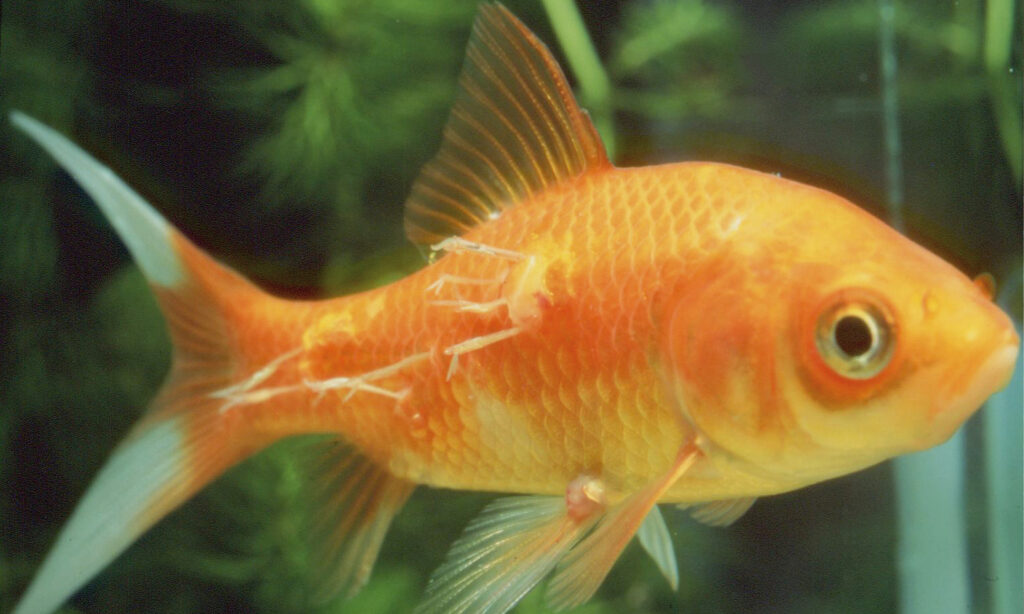
Here we unravel the intricate relationship your goldfish can unfortunately develop with anchor worms. It’s almost like one of those tragic love stories, where everyone except the lovestruck goldfish can see that the anchor worm is no good.
The Tricky Affair: How Goldfish Get Anchor Worms
Goldfish get anchor worms through contaminated water or food. The microscopic larvae latch onto our unsuspecting scaly friends, worm their way in (pun intended), and voila – they found their new home. It’s not the kind of moving in together story we enjoy, is it?
So, following this, we might think, “Easy peasy, just keep the aquarium clean, and we’re good.” Ah, if only. These pesky parasites can survive in various conditions, making them harder to get rid of than a clingy ex. Who knew your goldfish’s love life could be so complicated, right?
Spotting the Red Flags: Symptoms of Anchor Worms in Goldfish
Next, let’s learn to recognize when our goldfish are in a toxic relationship with anchor worms. In other words, we need to know how to spot the symptoms. Here’s the thing, goldfish aren’t much for conversation, so we need to observe.
As with any unwelcome guest, anchor worms create discomfort for your goldfish. They might constantly try to rub against objects. Think of it as them trying to shake off the uninvited guest. They also may lose their appetite, and there could be visible red sores or threads sticking out of their body.
Now that we know how this ill-fated love story unfolds and how to recognize it, how do we intervene? Glad you thought to ask. Let’s dive right into the diagnostic process and the potential solutions in our coming up section.
Diagnosing Anchor Worms in Goldfish
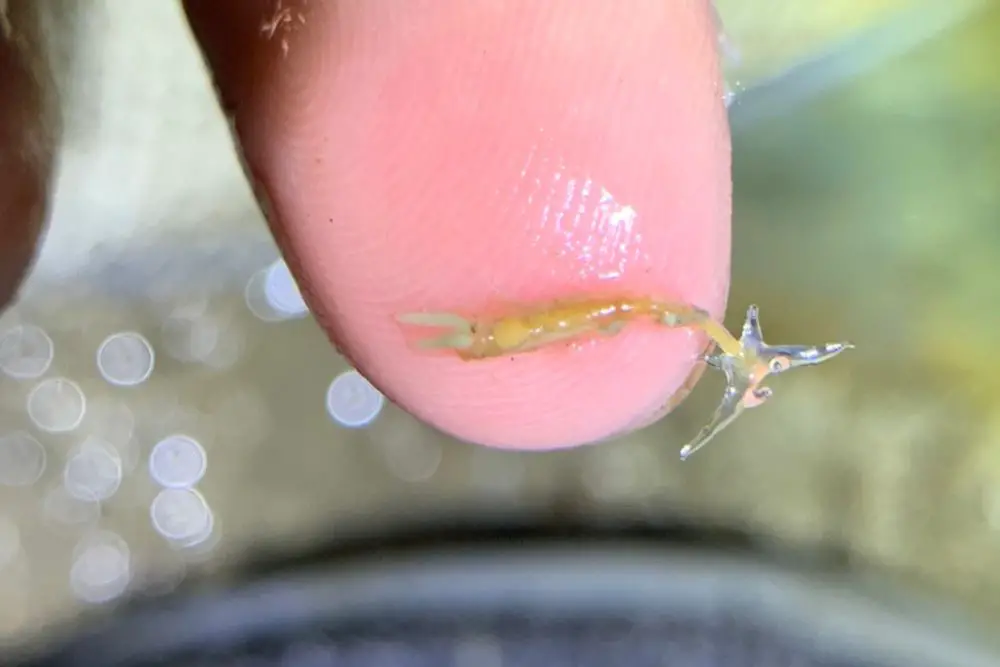
Ahoy, fish lovers! We’re entering crucial terrain—diagnosing anchor worms. Let’s break down this process into two waypoints: professional diagnosis and at-home DIY tips.
Professional Diagnosis
Nothing beats a keen expert eye when it comes to spotting anchor worms. A seasoned vet or aquarist makes this task less of a wild goose chase. They’ll examine your goldfish, looking for minuscule worm-like creatures on its skin or gills.
They may also observe your goldfish’s behavior. Anchor worms can turn your bubbly aquatic buddy into a sullen swimmer. So be prepared, fellow aquarists!
Fear not, though. If your Doctor Dolittle confirms anchor worms, he’ll prescribe a suitable treatment plan. You might even pick up valuable advice on preventive measures.
Diagnosing anchor worms, check. Let’s fish for some DIY tips next, shall we?
DIY Tips for Diagnosing Anchor Worms at Home
While nothing quite replaces professional examination, here are a few tips to help you spot these pesky parasites. But remember, folks, patience is key with these microscopic hitchhikers.
First, look for physical changes. Anchor worms often look like tiny threads, sticking out from your goldfish’s skin. Got a magnifying glass handy? You might need it.
Second, monitor your goldfish’s behavior. Notice any odd swimming pattern? Is your goldfish scratching itself against objects? Is it less sociable than usual? These could be the SOS signals of an anchor worm outbreak.
Now, you’re equipped with all the tools to launch your own anchor worms investigation. But remember, when in doubt, always consult a professional.
With the detective work behind us, let’s step into the arena of treatment methods, where we’ll find the cures to our wormy woes. Buckle up, goldfish guardians! Our deep dive continues.
Effective Treatment Methods for Anchor Worms in Goldfish

Now that you can spot an anchor worm from a mile off (or at least in your aquarium), let’s dive into how you can rid your goldfish of these pesky parasites. Brace yourself for a medley of medicinal jargon peppered with home remedies – it’s treatment time!
Medicinal Treatments
So, your goldfish has been diagnosed with anchor worms. You’re swapping your goldfish parent hat for a medical one. Your first line of defense? Over-the-counter treatments like formalin, potassium permanganate, or Praziquantel. This is like giving your goldfish a bubble bath with a twist. Be sure to adjust the dosage as per your aquarium’s capacity to avoid a chemical overload.
While this may sound like reading a foreign menu, fret not – your favorite pet store or online platform will help decode it. But remember, the right dosage is like the secret sauce to a perfect dish. Too much or too little can make the situation go under or over (out of control).
Next stop is using antibiotics, particularly the ones that target parasites. Before you imagine yourself miniaturizing and launching an operation inside your aquarium, hold on! Your vet can guide you through this.
Natural Treatments
Switching gears to the road less travelled, the natural remedy route. If you believe in the healing power of Mother Nature, salt baths could be your best bet. It’s not a spa retreat for your goldfish, but the saline solution could evict the anchor worms.
Preparing a salt bath is as easy as making your morning cup of joe. Simply dissolve a reasonable amount of sea salt per gallon of aquarium water and let your fish enjoy a soothing dip. Just remember, overdoing the salt can result in your fish channeling their inner pretzel.
There you have it, your medicinal and natural weapon against anchor worms. As we move on, let’s focus on preventing this unwanted guest from crashing your tank party in the future.
Preventing Future Infestation
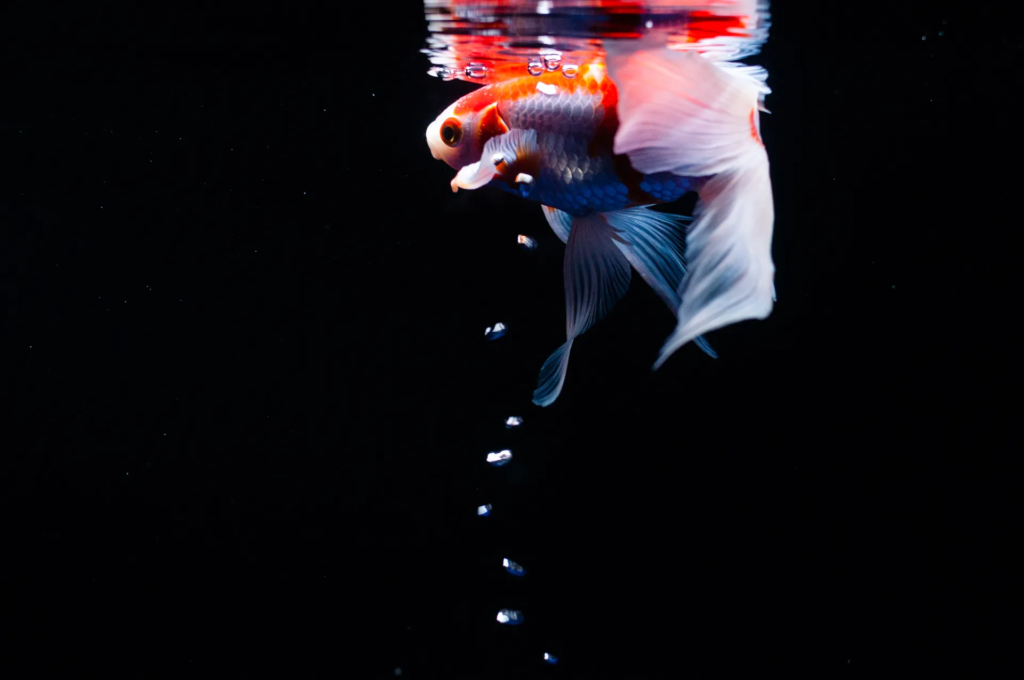
So, you survived the anchor worm apocalypse. Congrats! But how do we stop these pesky worms from returning? The answer lies in prevention.
Routine Checkups
We don’t want to catch you slacking now, do we? Just because the worms are gone does not mean it’s kick-back time. No, my friend, constant vigilance is the price of goldfish health-dom.
Introducing routine aquarium checkups! Simply put, routinize the process of observing your goldfish and their environment. Watch for any signs of discomfort or distress. Mysterious spots on the scales? Swollen gills? Unusual behavior? Take note. Should Bubble-O-Seven or Golden eye show any such symptoms, you know it’s time to act.
Importance of Aquarium Maintenance
Sure, your goldfish aren’t going to toss you the keys to a brand-new luxury car as thanks for keeping their home clean. But keeping that tank spotless isn’t for the nonexistent car; it’s for your golden sidekicks. Spick, span, and anchor worm-free is our goal here.
Regular tank cleaning and water changes will hold any potential parasites at bay, not just the anchor worms. Don’t forget the decor; anchor worm larvae love them. Think of it as ‘Tidy Space, Healthy Fish’.
Appropriate Feeding Techniques
Be honest. Who among us hasn’t been tempted to shower our aquatic pals with the fishy version of a buffet? Goldfish eating habits, however, are peculiar and overfeeding can make them susceptible to parasite infection, worms included.
Instead, aim for a balanced diet suitable for goldfish. Small, regular meals are better than an all-you-can-eat weekend brunch. Remember, the secret lies in moderation.
As we dive into the final section of our anchor worm odyssey, remember that love for your goldfish involves more than just admiring their graceful moves. It’s also about providing a clean, safe, and healthy environment for them to swim in bliss, free from any pesky anchor worms. After all, goldfish love – that’s what it’s all about. Stay tuned, goldfish guardians!
To Sum Up
Achieving an Anchor Worm-free environment for your goldfish hinges on understanding their life cycle, identifying symptoms, and robust diagnosis methods. A knowledge base, inclusive of both professional diagnosis and handy DIY tips, is ideal.
Treatment becomes more efficient with an understanding of medicinal and natural remediation. Future infestations can be swatted by adopting regular checkups, maintaining the aquarium’s hygiene, and proper feeding techniques. Victory against Anchor Worms is indeed achievable!
Frequently Asked Questions (FAQ)
Question: What exactly are anchor worms?
Answer: Anchor worms are crustacean parasites, scientifically called Lernaea. They’re called ‘anchor worms’ due to their anchor-shaped head used to attach to the host.
Question: How do goldfish contract anchor worms?
Answer: Goldfish usually get anchor worms from infected fish or contaminated water as the parasites can live in dormant stages in ponds and aquariums.
Question: What are the symptoms of anchor worms in goldfish?
Answer: Symptoms include erratic swimming, redness, inflammation around the site of attachment, and the visible appearance of the worm which looks like a tiny fiber extending off the goldfish’s body.
Question: Can a casual fish owner diagnose anchor worms?
Answer: While professional diagnosis is ideal, owners can look out for visible symptoms including small green or red protruding threads from the fish’s body which may indicate an anchor worm infestation.
Question: What course of treatment is recommended?
Answer: Both medicinal and natural treatments work. These can range from antibiotics to natural remedies like salt baths. It’s important to consult with a vet for the best treatment approach.
Question: How can future anchor worm infestations be avoided?
Answer: Prevention is key. This includes regular aquarium cleanliness, proper feeding, and segregation of any infected fish to avoid the spread of anchor worms to other aquarium inhabitants.

